In this article, you will learn the different parts of motorcycle and their functions. All explained with Names & Pictures.
If you need a PDF file, download it at the end of the article.
Motorcycle Parts
A motorcycle is a two-wheeled vehicle driven by an engine with no pedals. Motorcycles can vary in design for several factors, including performance, form, and cost, but the basic anatomy of any motorcycle remains the same.
You love to ride your motorcycle but have only insufficient knowledge of its parts. While you don’t need to be a professional mechanic, you should know about the parts to make intelligent decisions when replacing them.
Therefore, I created a reference guide about a motorcycle’s essential components and parts, along with a brief description of what the device does and where it is found on a motorcycle. The essential components of modern motorcycles are listed below.
Don’t Miss Out: The Comprehensive Guide on Car Engine Parts: Its Function (Pictures)
Parts of Motorcycle
Following are the main parts of motorcycle:
- Engine
- Transmission
- Frame
- Clutch lever
- Front brake lever
- Rear brake lever
- Throttle
- Gear shifter
- Horn
- Pegs
- Engine guards
- Signal lights
- Headlights
- Mirrors
- Start button
- Choke
- Ignition key switch
- Fuel tank
- Tires
- Rims
- Brakes
- Kickstand
- Suspension
- Exhaust/pipe
- Seat
- Battery
- Dashboard
- Tachometer
- Speedometer
- Storage
Read Also: Different Types of Engine and Their Functions (Images)
#1 Engine
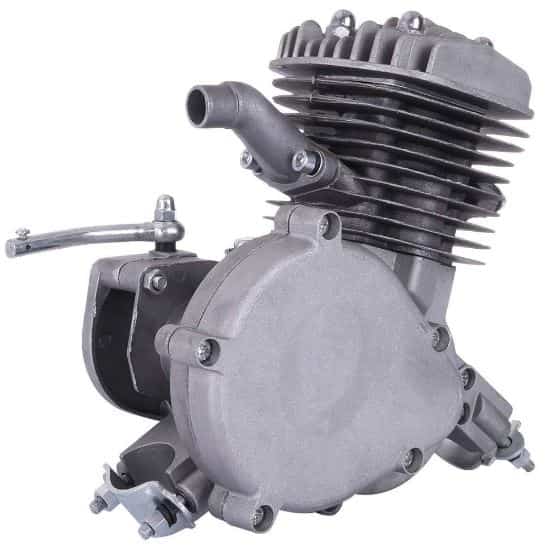
The bike engine keeps the motorbike running as it controls the transmission and other processes related to the engine’s smooth operation. One of the essential parts of an engine is its valve which allows air and fuel to circulate to create combustion.
Almost all commercial motorcycles are powered by conventional gasoline internal combustion engines. But some models use an electric motor and diesel engine. Motorcycles are mostly, but not exclusively, built with one to four cylinders.
The most common configurations for today’s engines are single and twin, V-twin, opposite twin (or boxer), and in-line triple and in-line four. Engines with more cylinders for the same displacement make it easier to ride, while engines with fewer cylinders are cheaper, lighter, and easier to maintain.
Common Engine Configurations:
Liquid-cooled motorcycle engine: It consists of a radiator which is the primary way their heat is dissipated. Coolant or oil continuously circulates between the radiator and the cylinder when the engine is running. These engines have the potential for greater power at a given displacement, closer tolerances, and longer operating life.
Air-cooled motorcycle engine: It depends on air blowing the rear fins on the engine case to dissipate heat. These are cheaper to buy, less mechanically complex, and lighter. An air-cooled engine shrinks and expands along its wide temperature range requires looser tolerances, and gives shorter engine life.
Two-stroke engine: Two-stroke motorcycle engines are lighter and much simpler mechanically. It produces more power when operating at its best. Most modern two-strokes are single-cylinder, liquid-cooled, and under 600 cc.
Four-stroke engine: Four-stroke motorcycle engines are cleaner, more reliable, and provide power over a broader range of engine speeds.
#2 Transmission
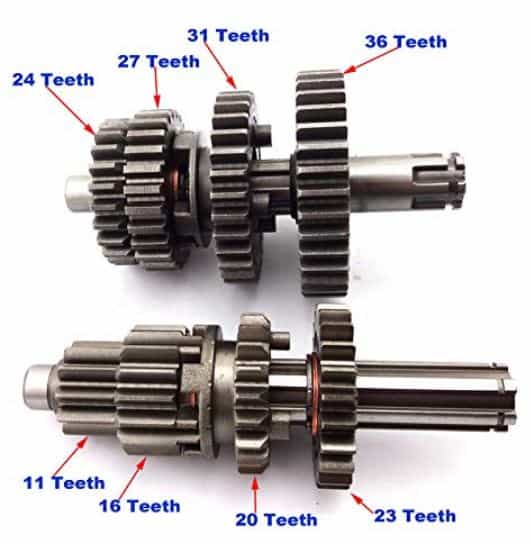
Typically, the motorcycle uses a sequential manual transmission moved by a foot lever. Some small motorcycles and many scooters use a continuously variable or hydraulic automatic transmission.
It requires a rider’s input to change gears, but the clutch system is controlled and operated automatically. These systems are mostly found on small dirt bikes, many older mopeds and scooters, and many other types of motorcycles.
#3 Frame
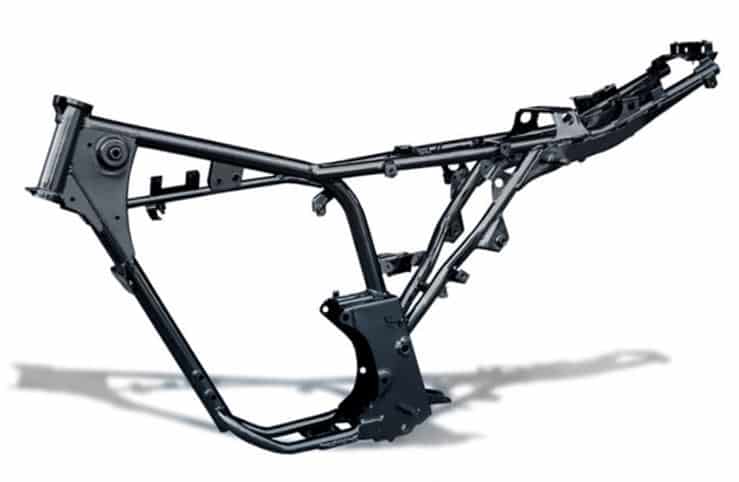
A motorcycle frame is the main structure of a motorcycle that forms its skeleton. It helps to support the engine and provides a space for the steering and rear suspension. It also supports the rider and any passengers or baggage.
It is usually made of welded aluminum or alloy steel struts, with the rear suspension being an integral part of the design. Carbon fiber, titanium, and magnesium are used in some costly motorcycle frames. In addition, there are fuel tanks and batteries attached to the frame.
#4 Clutch Lever
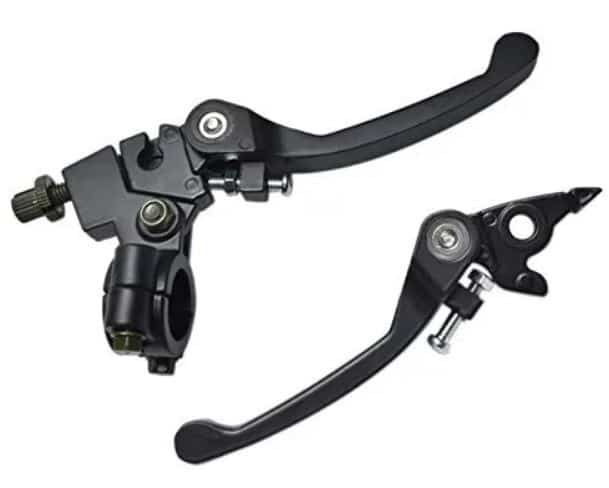
The clutch lever on the motorcycle is located on the left side of the handlebar. It disengages and engages power from the engine to the rear wheel. The rider has to use the left hand to pull the clutch lever towards the grip.
When the rider pulls the clutch lever, the clutch spring contracts, causing the pressure plate to retract. This splits the friction and steel plates, so they spin freely. Thus the clutch disconnects the engine from the transmission. Therefore, the power to the rear wheel is stopped, and the gears can be changed.
#5 Front Brake Lever
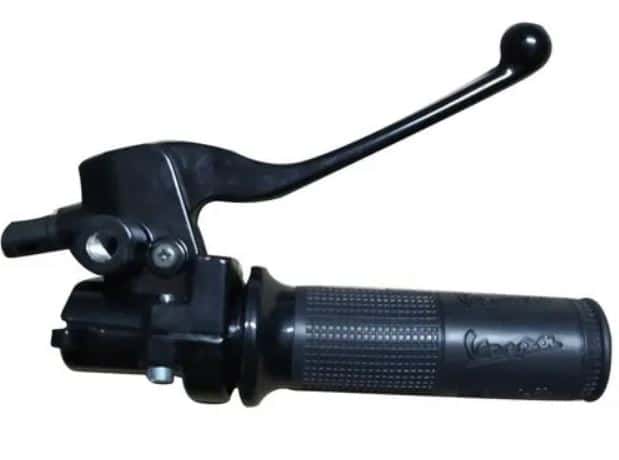
Most motorcycle brakes actuate the two wheels independently, with a lever on the right side of the handlebar to operate the front brake. When it is pulled, actuate the brake (either by pulling the cable or compressing the hydraulic fluid) for you to stop.
It works by transferring motion and force on the levers through an incompressible fluid to the caliper pistons, which then press the brake pads against the discs. To transfer that force efficiently, the brake lines must not expand, have no leakage, and not compress the fluid.
Read Also: Different Types of Clutches and How they Work?
#6 Rear Brake Pedal
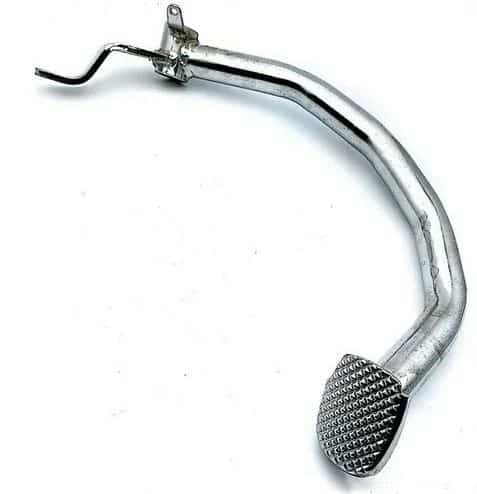
Using the rear brake pedal, riders can keep their right hand fully on the throttle to roll over and turn. This allows the use of the clutch in this position to stop and start very slowly. It’s like an aircraft touch where you go slow and then accelerate without stopping.
Usually, the rear brakes are designed to provide stability. Otherwise, they will lock up every time you depress the brake pedal. The more force you apply to the brake pedal, the more braking power is transmitted to the rear wheel.
#7 Throttle
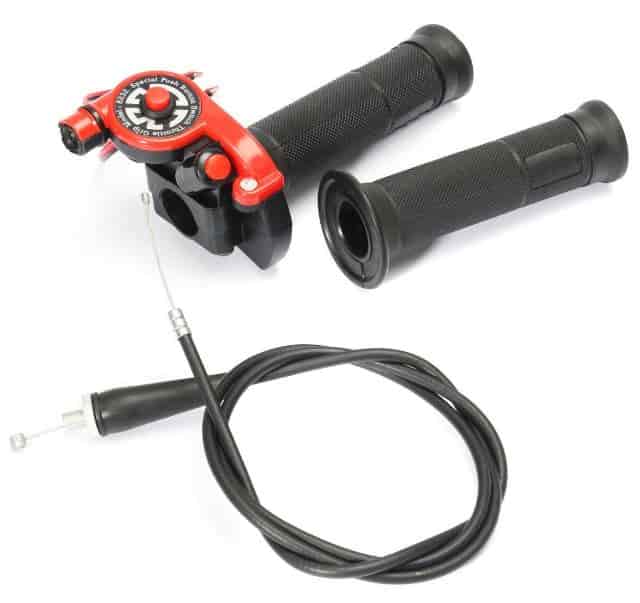
In other words, the throttle is the correct handlebar grip on the motorcycle. This is known as a “twist-grip throttle” because you have to twist the grip with your wrist to control the engine. It is commonly known as an accelerator.
The device controls fuel and airflow into the engine, producing more or less power output. It controls how much air is allowed to flow through the carburetor, and the airflow controls how much fuel is also pumped into the engine. To accelerate the motorcycle, turn the throttle grip towards you. Similarly, to slow down, roll the throttle away from you.
#8 Gear Shifter
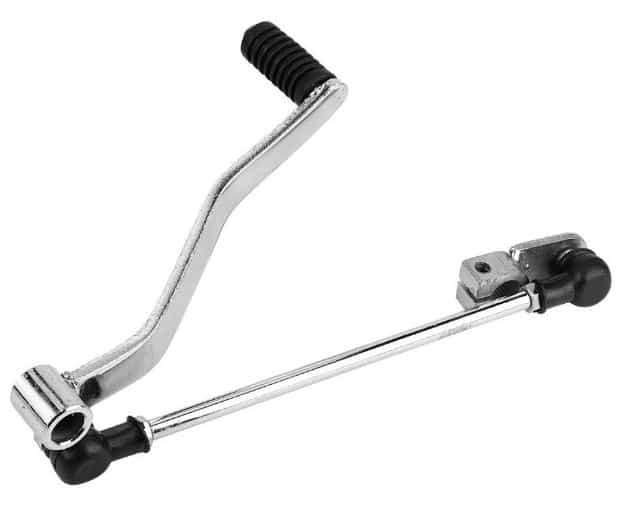
A gear shifter is a control on a motorcycle that shifts the gears of the transmission up or down. Motorcycles such as scooters and some automatic models may not have this control. Some motorcycles have pedal or button shifting options but are few and far between.
You must use the ball of your foot to push down for downshifting and your foot’s top “base of your toes” to push up on the lever to shift gears. The gear shifter operates sequentially, meaning you must go through each gear and not skip any. Keep in mind that when stopping, always maintain your bike in neutral.
#9 Horn
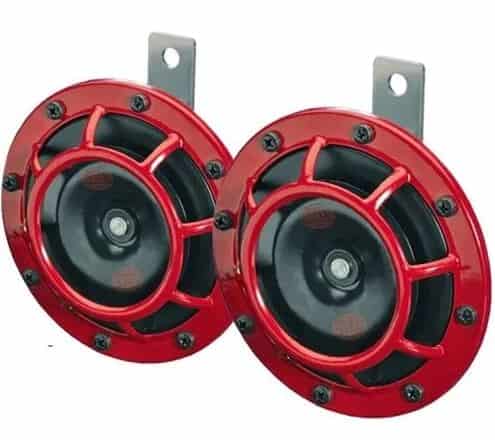
Pressing the horn button on the handlebar activates the electromagnet, which stretches the diaphragm until it touches a set of contact points. It breaks the electromagnet’s pull on the steel and returns the diaphragm to its original process to begin the cycle again.
It is essential in every type of automobile vehicle as an alert system. The horn should only sound to warn other road users of imminent danger when a motorcycle is in motion. You must alert other motorists about your presence while traveling around a turn.
#10 Pegs
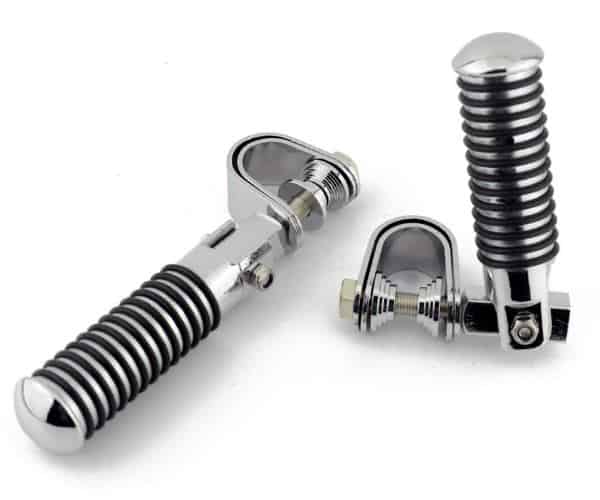
These are used to rest and protect your feet and give you a reference point for using your foot control. Whether mounted on the front, rear, or both, pegs allow riders to center their weight on the wheel.
You should keep the ball of your foot on the peg and move it back and forth on the controls as needed. Place your footrest or crest on the peg, but your foot is outward (the foot can alternately get stuck on the road).
Read Also: 12 Types of Car Headlights [When & How to Use?]
#11 Engine Guards
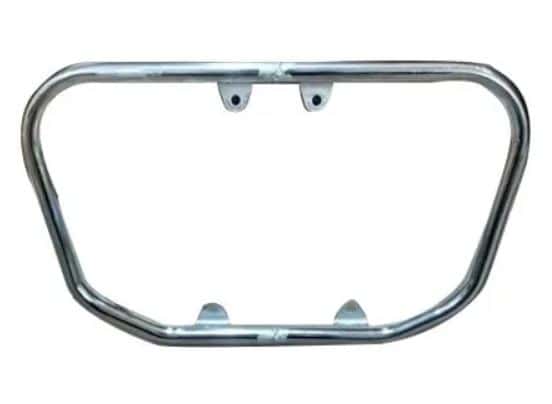
While driving on the road, keeping yourself and your motorcycle safe in an accident is essential. Motorcycle engine guards help protect your bike’s engine in the event of an accident. It’s worth the money, easy to set up, and has an accommodating staff.
These engine guards are known to serve as the first point of contact between your bike and the ground in the case of a skid. In addition, it will prevent damage to the crankcase and avoid trapping your foot when falling to the ground.
#12 Signal Lights
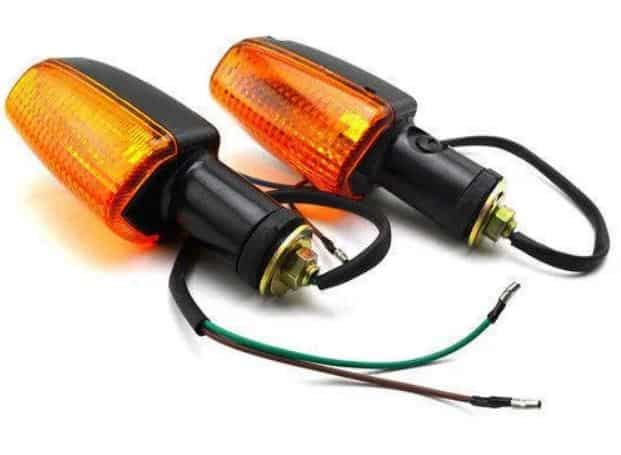
The signal light is usually found on the left side of the handlebar, directly next to the left handgrip, for easy access with the left hand. To turn on the signal light, you move the lever to the left or right to signal the direction you’re turning.
Furthermore, it will give a very stylish look to the motorcycle and help you take safe turns on the road. These LED lights are incredibly bright and have a long shelf life, so visibility won’t be a concern if you’re on the road at night or in the middle of heavy rain or fog.
#13 Head Lights
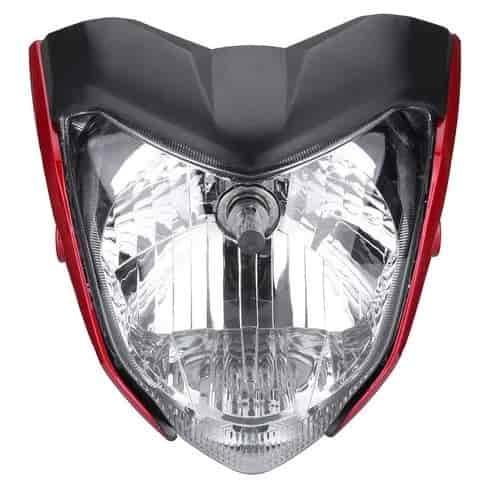
The headlights are one of the most critical safety features of a motorcycle. They work to give visibility in low light conditions or at night, and they also let people know you’re there. It is also helpful in difficult light conditions like dusk, during dawn, or when there is a sudden cloud cover.
Controls for the headlights can be found on the left control module and often have a toggle switch between low beam (regular running lights) and high beam (allowing the headlights to shine further).
#14 Mirrors
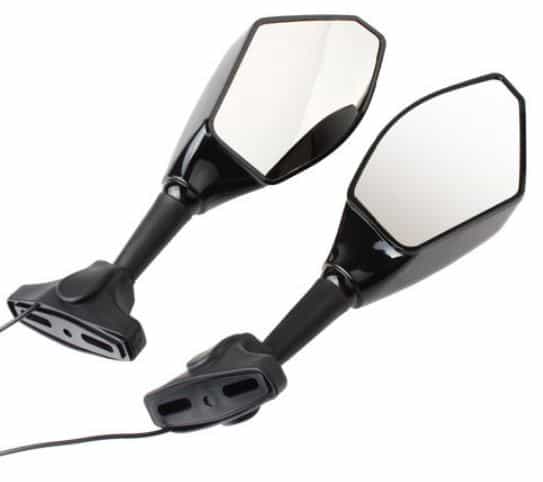
Almost all motorcycles, cars, and other vehicles include side mirrors, vital for smooth driving. Drivers can get an idea of oncoming traffic from behind with these mirrors.
According to annual traffic statistics, many accidents are caused by faulty and not seeing the mirrors at the right time. Convex mirrors are used in motorcycles to view individual objects, providing a larger field of view than plane mirrors.
#15 Start Button
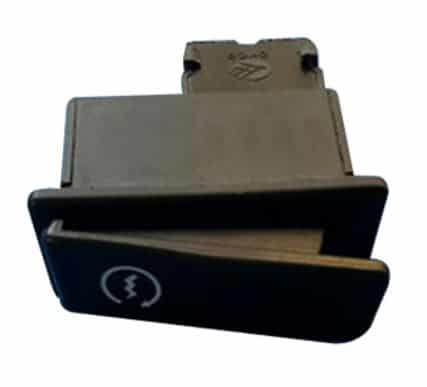
Also known as a kick-start, it is typically found on the right control module, next to the handgrip. The push button will usually have the symbol shown on the left or be labeled “START.” The kick starter is an external lever attached directly to the engine’s crankshaft.
Kick-starting causes the crankshaft to rotate, pushing the piston against the piston head, and creating friction. This builds up pressure, and the fuel and air mixture pumped from the valve is ignited. Thus the engine heats up, and the motorcycle starts.
Read Also: 25 Car Dashboard Warning Lights and Indicators [Explained]
#16 Choke
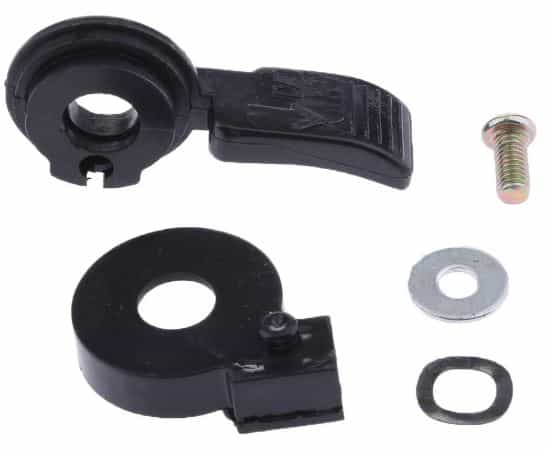
You almost exclusively have the choke feature with carbureted motorcycles. A cold engine does not vaporize fuel efficiently, resulting in roughness and stalling. Chokes must be used to “choke” the airflow and allow for a richer fuel mixture.
It is used only when starting your engine in cold conditions. Once you get up and running smoothly, please turn it off. The choke has a symbol that is usually located on the left side. Sometimes it can be challenging to detect as its location and mode of activation may vary depending on the model.
#17 Ignition Key Switch
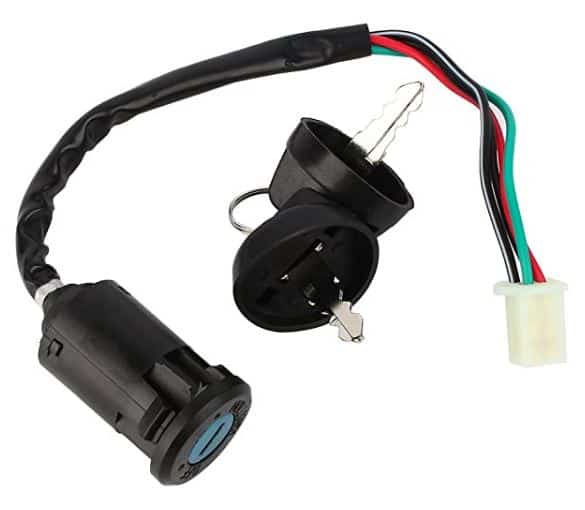
Also known as an ignition switch or starter switch is a crucial switch in a motor vehicle’s control system that activates the vehicle’s central electrical systems. The switch provides power to the starter solenoid and ignition system components in internal combustion engine vehicles.
This is often combined with the starter switch, which activates the starter motor. It is located in a few places on the motorcycle but is usually found around the handlebar or on the side of the motor. Turning the key will power the rest of the motorcycle.
#18 Fuel Tank
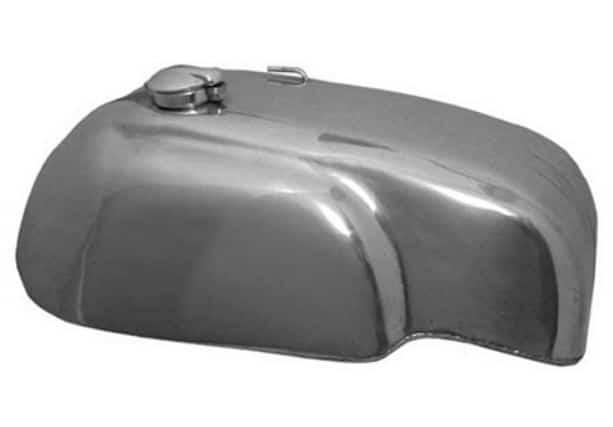
As everyone knows, the primary function of the fuel tank is to hold fuel only. Also known as a petrol tank or gas tank, the term is usually applied to the part of an engine system in which fuel is stored and operated (fuel pump) or released (pressurized gas).
However, it also provides a safe area for knees to hold while riding, which is an essential point of contact between bike and rider. Motorcycle fuel tanks usually hold about 1.5 – 8.5 gallons of gas, but most have a gas tank with 3 – 6 gallons capacity.
#19 Front Fork
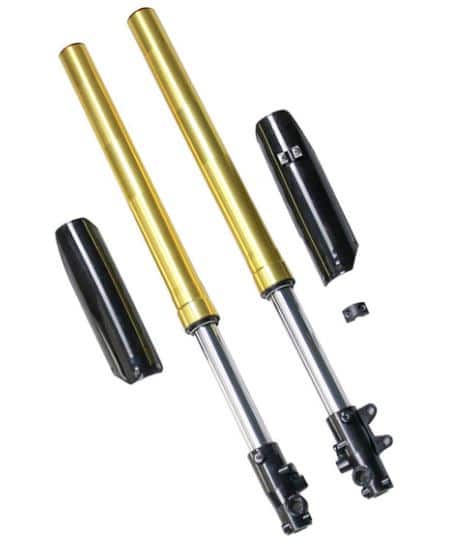
It is the part of a motorcycle that holds the front wheel and allows one to steer. The front fork is the most crucial part of handling the motorcycle. The combination of rake and trail in the front fork determines how stable the motorcycle is.
Forks have yokes that hold the fork tube (which contains the fork springs) and are fastened by the steering stem to the neck of the frame. The lower legs of the forks are known as sliders that hold the damping assemblies. The front axle is positioned vertically and engages the sliders. The handlebars are attached to the top triple tree, allowing the rider to steer the motorcycle.
#20 Tires
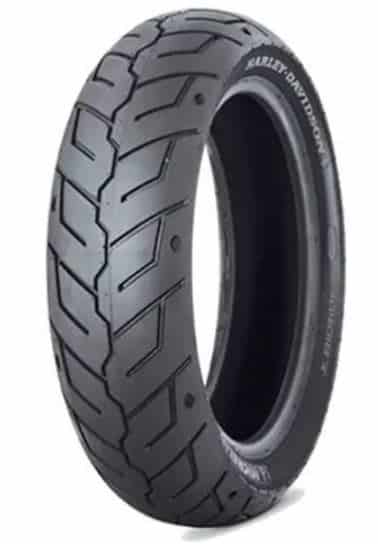
Tires play an important role as they are the only link between the vehicle and the road. A tire not only transmits the motor’s power to the road but also absorbs shocks from uneven road surfaces.
In addition, it supports the vehicle’s weight and transmits accelerating and braking force to the ground. Your safety depends not only on the maintenance of the tires but also on the choice of tires. Checking your tire pressure to ensure they are correctly inflated can make a real difference in how long your tires last.
Read Also: Types of Tires for Cars [Explained with Their Purposes]
#21 Rims
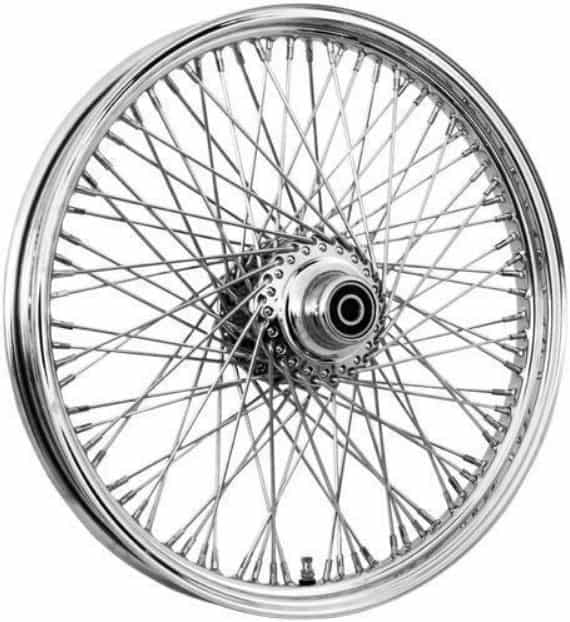
Wheel rims are steel or aluminum (usually with spokes and aluminum hub), mag-type cast, or machined aluminum. A rim is the frame of a tire that holds the force and tension caused by the vehicle’s weight and the effects of various road conditions.
The manufacturers have carefully considered and enhanced the safety of the rim to prevent any accidents due to rim failure or deformation. Proper fitting between the tire and the rim is essential for tubeless tires to seal the air. Older models had inner tubes between the rim and the tire.
#22 Brakes
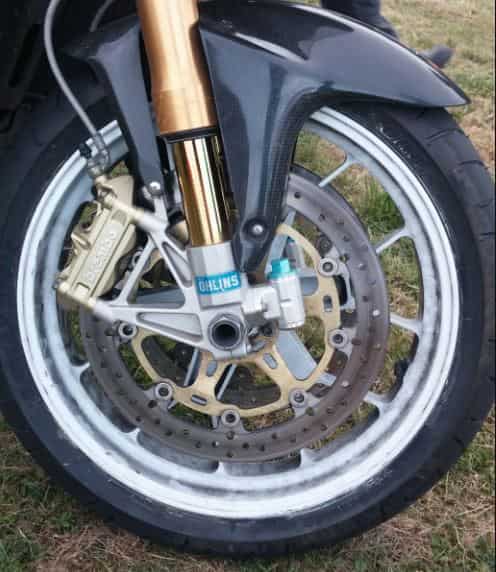
Motorcycles typically have two independent brakes, one on the front wheel and one on the rear. Nevertheless, some models have “linked brakes,” whereby both can be applied simultaneously using only one control.
It works by transferring motion and force on the levers through an incompressible fluid to the caliper pistons, which then press the brake pads against the discs. Disc brakes and drum brakes are two braking systems used in today’s motorcycles.
- Disc Brake: Disc brakes are widely used in motorcycles, especially the larger ones, as disc brakes can have significantly higher braking power.
- Drum Brake: These brakes were used regularly before the invention of disc brakes. Some manufacturers may still use these brakes on smaller motorcycles or as a rear brake because the rear brake does not provide as much braking power.
#23 Kickstand
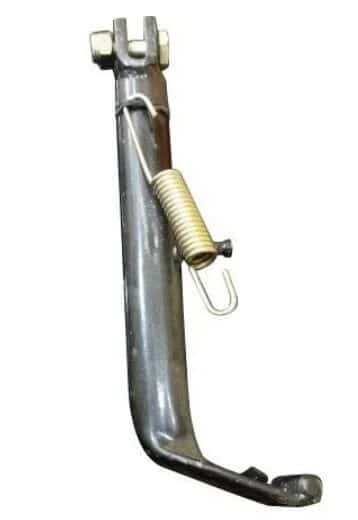
A kickstand on a motorcycle permits the bike to be held upright without leaning over the aid of another object or a person. A kickstand is usually a type of metal that slides down from the frame and makes contact with the ground. Generally, there are two types of kickstands used in motorcycles.
- Side stand: Almost all motorcycles have a side stand, and the left side is always roughly under the footpeg.
- Center stand: Not all motorcycles have this, but those that can keep the weight of their bike almost entirely upright can benefit from storage and maintenance.
#24 Rear Suspension
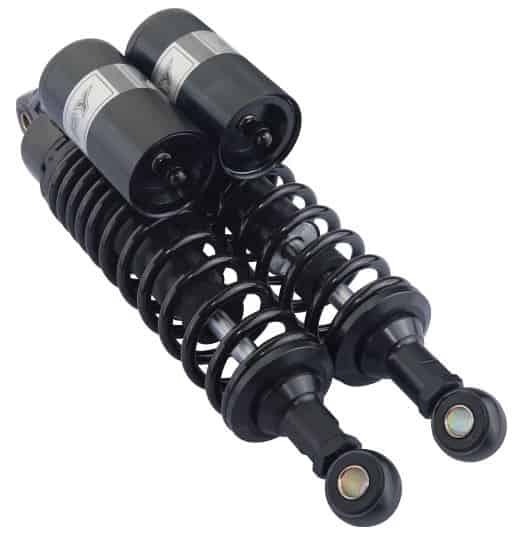
The rear suspension of the motorcycle uses a spring and damper combination to isolate the chassis and rider from road defects. The motorcycle uses a single shock absorber rear suspension, which connects the rear swingarm to the motorcycle’s frame.
Usually, this shock absorber is in front of the rear wheel and uses a linkage to attach to the swing arm. The design of the rear suspension can be very different compared to the front suspension. It works with the front suspension to reduce road or trail impact. Some motorcycles don’t have rear suspension.
#25 Exhaust Pipe
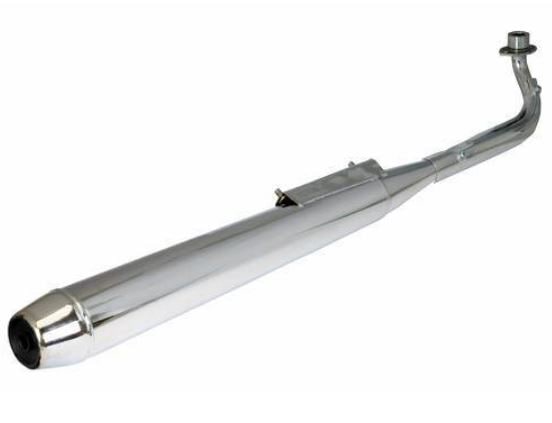
The primary purpose of the exhaust system is to direct post-combustion gases from the engine cylinders and away from the driver into the atmosphere. It also provides for the smooth running of the engine by supplying back pressure through the length of the pipe and the cross-sectional area.
Most of the exhaust pipes are mounted back along the bottom of the motorcycle, exhausting the riders’ rear. Some motorcycles now do away with the bottom, depending on the make and model. The pipe is a common modification in motorcycles, usually to give the motorcycle a louder sound and sometimes changes the form or location of the pipe.
Read Also: Types of Suspension System used in Vehicles (Complete Guide)
#26 Seat
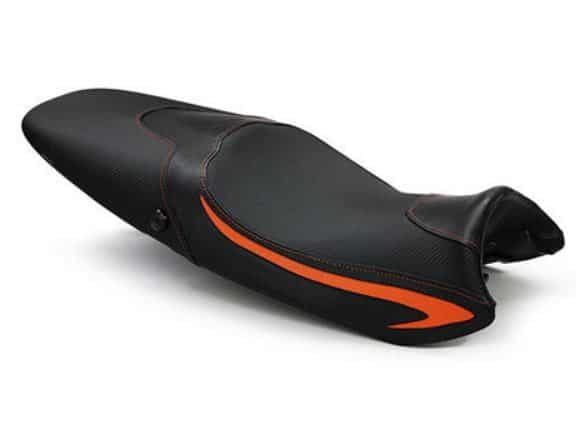
Every motorcycle has a driver seat, but the size, shape, and place of the seat can vary depending on the motorcycle you ride. A motorcycle seat is where the rider sits and can accommodate a passenger.
The motorcycle’s seat mounts over the chassis and is large enough for a passenger to mount the motorcycle behind the rider. Dual saddle or bench seat is the most common type of motorcycle seat. A single or solo seat is usually large enough for a rider used in racing and off-road motorcycles.
#27 Battery

The battery in a motorcycle is similar to that of a car’s battery, which provides power to the engine and other accessories. It supplies additional current when the charging system cannot meet the power demand.
Also, it acts as a voltage stabilizer for the charging system. Motorcycle batteries are almost always under the rider’s seat. These types of batteries are usually much smaller than those in cars, so they cannot last long without the engine running.
#28 Dashboard
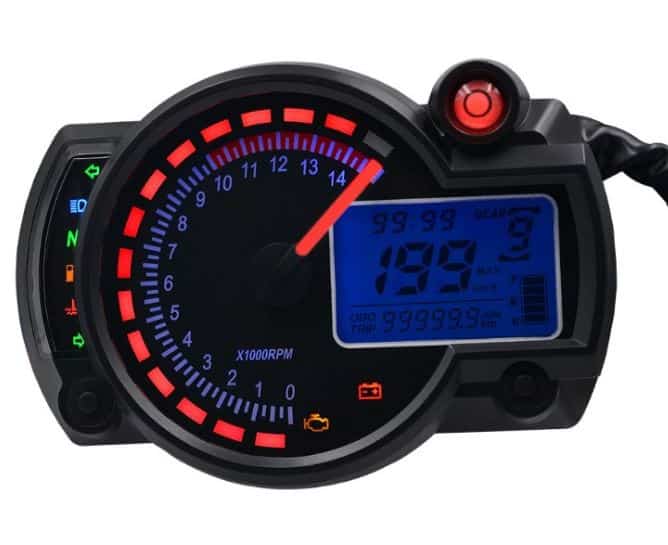
The motorcycle’s dashboard is critical in communicating messages from the vehicle to its operator. It consists of an instrument panel, which usually houses the speedometer, odometer, and tachometer.
The dashboard may vary in location and configuration as per the motorcycle’s make and model. But it is always found above or below the handlebar as it needs to be in plain view while sitting on the motorcycle.
- Warning Lights: Most motorcycles have warning indicators, so as motorcycles become more complex, you may see additional warnings.
- Tachometer: It indicates the current RPM value produced by the motorcycle. Not all motorcycles have a tachometer.
#29 Speedometer
A speedometer is a type of gauge that measures and displays the instantaneous speed of a vehicle in miles/kilometers. Apart from this, it also displays the mileage of the vehicle. Using a speedometer can also prevent motorcycle accidents. The rider can control the speed and thus restrict speeding unnecessarily.
#30 Storage
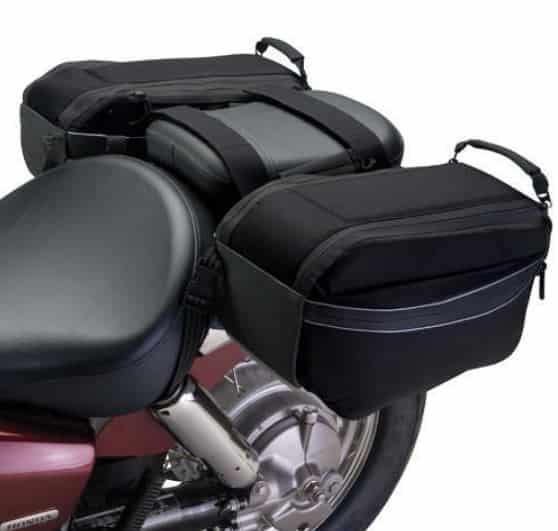
Motorcycles do not have any storage, except for some models of motorcycles made for long-distance travel. So if you want to store accessories on a motorcycle, you will need to get third-party accessories to bring the items with you.
But some older models had a storage compartment mounted behind the seat, often supplemented by panniers or saddlebags. In addition, some common options are listed below:
- Rear carrier bag: This storage can be either a bag or box mounted on the back seat of the motorcycle.
- Tank bags: This bag has straps or magnets that mount to the fuel tank to provide storage options.
Wrapping It Up
The above-mentioned motorcycle parts are very essential for its convenient use. I have listed all the necessary information about motorcycle parts that will help new motorcyclists learn to ride.
So now, I expect I’ve covered everything about “Parts of Motorcycle“. If you still have any doubts or questions on this topic, you can contact us or ask in the comments. If you like this article, then please share it with your friends.
Want free PDFs direct to your inbox? Then subscribe to our newsletter.
Download PDF of this article:
You might like to read more in our blog:
Explore ’30 Basic Parts of Motorcycle & Their Functions’—a helpful guide breaking down bike essentials for everyone, especially those starting their motorcycle journey
Thanks for your feedback.
Wonderful, this is the best article that details me all about motorcycles parts
Thanks for your feedback.
Love All The Work You Do & This Information is both exciting and useful to know. I am Able to Identify These Parts Faster now. Thanks
You’re welcome! Glad it’s helpful.
This article provides a comprehensive overview of the 30 basic parts of a motorcycle and their functions. It’s a valuable resource for both novice and experienced riders
Thanks for your feedback.
This is awesome! I never found article that provides me with all that I need to know about motorcycle parts till now. Thank you for making it easier to learn and find everything on one place.
I did some research and decided what to buy. Good luck to you!
Thanks for the great feedback! We’re glad the article was helpful in finding information on motorcycle parts. Good luck with your purchase!
Please I would like to have an in depth knowledge of a complete parts of a Motorcycle. Thank you!
You’re welcome. Sure, I will provide in-depth knowledge about this.
Hi I would like to learn more about new technology in Machines please . And thank you
You’re welcome. Keep visiting 😉